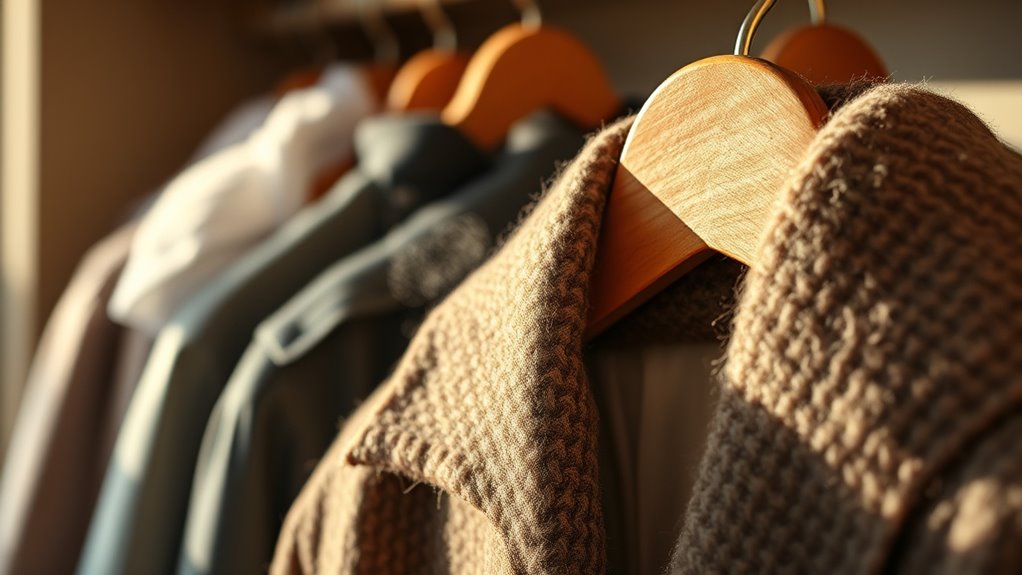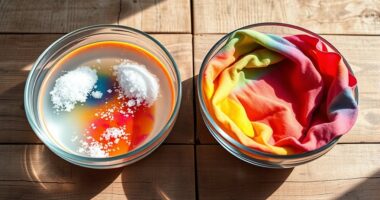You should dry-clean your wool coat once or twice each season if you wear it regularly. More frequent cleanings are needed if it gets exposed to pollution, stains, odors, or sees heavy use. Lightly used coats may only need cleaning every few months. Pay attention to signs like bad smells or visible dirt, and if you’re curious about maintaining your coat’s best condition, there’s more to discover on proper care.
Key Takeaways
- Dry-clean wool coats once or twice per season for regular wear.
- More frequent cleaning may be needed after exposure to pollution, rain, or heavy sweating.
- Signs like odors, stains, or a dull appearance indicate it’s time for cleaning.
- Regular brushing and spot cleaning can extend the interval between professional cleanings.
- Proper storage and airing out help maintain fabric quality and reduce cleaning frequency.

Wool coats are durable and stylish, but knowing how often to dry-clean them can be confusing. The key is understanding the right cleaning frequency to keep your coat looking sharp without compromising the fabric’s integrity. Wool is naturally resilient, but improper cleaning can cause it to lose its shape, become pilled, or wear out faster. When contemplating fabric maintenance, you want to strike a balance—clean it too often, and you risk damaging the fibers; wait too long, and dirt or oils can settle in, making the coat look dull and possibly developing odors.
In general, you should plan to dry-clean your wool coat at least once or twice a season, especially if you wear it regularly. If you’re in a city with a lot of pollution or if you tend to sweat more when wearing the coat, more frequent cleanings may be necessary. For lighter use, such as occasional wear, every few months might suffice. Pay attention to signs of dirt, stains, or odors—these are clear indicators that your coat needs professional cleaning. Remember, fabric maintenance isn’t just about appearance; it’s also about preserving the wool’s natural properties and ensuring longevity.
It’s also worth considering how your wool coat is stored and cared for between cleanings. Regular brushing with a garment brush helps remove surface dust, lint, and dirt, reducing the need for frequent dry cleaning. Spot cleaning minor stains immediately with a damp cloth can prevent them from setting in, which helps extend the time between professional cleanings. Good storage habits, like hanging your coat on a wide, padded hanger and keeping it in a breathable garment bag, prevent deformation and keep it fresh longer.
Another aspect to consider is the influence of external factors on your coat’s fabric maintenance. If you’ve been caught in rain or snow, it’s best to let the coat air out thoroughly before storing it. If odors develop or if the coat feels greasy or sticky, a dry-cleaning session becomes necessary sooner rather than later. Conversely, if your coat looks and smells fresh after wearing, and you’ve taken good care of it with brushing and spot cleaning, you may delay the next professional cleaning. Regular maintenance, including the use of Glycolic acid, can also help in keeping the fabric’s appearance and texture in top condition.
Frequently Asked Questions
Can I Spot-Clean My Wool Coat Instead of Dry-Cleaning?
You can spot-clean your wool coat instead of dry-cleaning, but use proper stain removal techniques. Gently blot stains with a clean, damp cloth and mild detergent, avoiding excessive rubbing. For tough spots, consider alternative cleaning methods like using a wool-safe stain remover. Keep in mind that frequent spot-cleaning may not fully replace professional dry-cleaning, especially for deep-set stains or overall maintenance, so balance both approaches for best results.
How Can I Tell if My Wool Coat Needs Dry-Cleaning?
Think of your wool coat as a trusted friend; it shows signs when it needs a spa day. If stains become a stubborn shadow or fabric durability weakens, it’s time for a dry-cleaning visit. Look for visible stains or signs of dirt that won’t brush away. When in doubt, a professional clean keeps your coat looking sharp and helps it last longer, preserving its charm and warmth.
Is It Safe to Wash a Wool Coat at Home?
You can wash a wool coat at home, but it’s essential to be cautious. Use gentle, eco-friendly cleaning methods like hand washing or cold-water machine cycles, and always check the care label first. Avoid harsh detergents to prevent damage. Home laundry is convenient and eco-friendly, but if your coat’s delicate or heavily soiled, professional dry cleaning might be safer. Always air dry your coat to preserve its shape.
What Are the Signs of Damage From Dry-Cleaning?
You might notice dry-cleaning residue on your wool coat, which can cause skin irritation or stiffness. Over time, repeated dry cleaning can weaken the fabric, leading to tears or thinning areas. Look for dullness, loss of shape, or persistent stains that don’t come out easily. If you see these signs, it’s time to contemplate alternative cleaning methods or consult a professional to prevent further fabric weakening and damage.
Does Frequent Dry-Cleaning Affect the Coat’S Lifespan?
You’re asking if frequent dry-cleaning impacts your coat’s longevity. It’s a fine line—you don’t want to wear out the fabric, but you also need to keep it looking sharp. Excessive dry cleaning can wear down fibers, shortening your coat’s lifespan. To preserve your coat, limit dry-cleaning to when it’s truly necessary, and follow care instructions. Striking a balance guarantees your coat stays stylish and durable for years to come.
Conclusion
Think of your wool coat as a timeless piece of art—you want to keep it looking its best for years to come. Usually, dry-cleaning once or twice a season is enough to preserve its beauty and integrity. Over-cleaning can be like over-polishing a masterpiece, dulling its charm. So, treat your coat with care, and it’ll continue to be your trusty, stylish companion through many seasons. Your wardrobe’s masterpiece deserves just the right touch.










